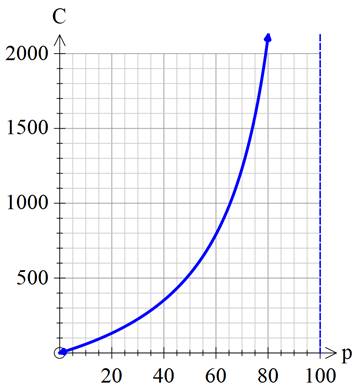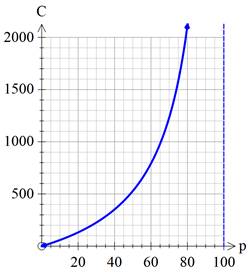
Concept explainers
a
To determine the cost of seizing 25%, 50%, and 75% of illegal drug
a
Answer to Problem 137RE
For 25%, the seizing cost = $176 million
For 50%, the seizing cost = $528 million
For 75%, the seizing cost = $1584 million
Explanation of Solution
Given:
The given relation is:
Where, C is the cost of seizing p % of illegal drugs in millions of dollars.
p is the percentage of seizure of illegal drugs.
Calculation:
Now, when percentage seizure is 25% , p = 25
Then,
This means in order to seize 25% of illegal drugs, the cost comes out to be $176 million.
Similarly,
When p = 50,
This means in order to seize 50% of illegal drugs the cost comes out to be $528 million.
Again,
When p = 75,
This means in order to seize 75% of illegal drugs the cost comes out to be $1584 million.
Conclusion:
For 25%, the seizing cost = $176 million
For 50%, the seizing cost = $528 million
For 75%, the seizing cost = $1584 million
b
To graph the function for the given relation
b
Explanation of Solution
Given:
The given relation is:
Calculation of Graph:
Consider
| Values of p | Values of C |
| 25 | 176 |
| 50 | 528 |
| 75 | 1584 |
By considering various values of p , the graph can be plotted.
Graph:

Interpretation:
The graph shows increasing nature throughout and it becomes asymptotic at p = 100.
Also, the domain is:
By seeing the domain and range of the graph, the viewing window has been selected, such that the asymptotic nature of the graph at p = 100 is clearly visible.
c
To determine whether 100% seizure is possible or not.
c
Explanation of Solution
Given:
The given relation is:
Graph:

Interpretation:
From the above graph, it is clear that, the curve never meets the graph at p = 100.
So, it is impossible to seize 100% of the drug.
Conclusion:
Hence, 100% seizure of the illegal drugs is not possible.
Chapter 2 Solutions
Precalculus with Limits: A Graphing Approach
- What is the particular solution to the differential equation y′′ + y = 1/cos t ?arrow_forwardWhich of the following is the general solution to y′′ + 4y = e^2t + 12 sin(2t) ?A. y(t) = c1 cos(2t) + c2 sin(2t) + 1/8 e^2t − 3t cos(2t)B. y(t) = c1e^2t + c2e^−2t + 1/4 te^2t − 3t cos(2t)C. y(t) = c1 + c2e^−4t + 1/12 te^2t − 3t cos(2t)D. y(t) = c1 cos(2t) + c2 sin(2t) + 1/8 e^2t + 3 sin(2t)E. None of the above. Please include all steps! Thank you!arrow_forwardShow that i cote +1 = cosec 20 tan 20+1 = sec² O २ cos² + sin 20 = 1 using pythagon's theoremarrow_forward
- Find the general solution to the differential equationarrow_forwardcharity savings Budget for May travel food Peter earned $700 during May. The graph shows how the money was used. What fraction was clothes? O Search Submit clothes leisurearrow_forwardExercise 11.3 A slope field is given for the equation y' = 4y+4. (a) Sketch the particular solution that corresponds to y(0) = −2 (b) Find the constant solution (c) For what initial conditions y(0) is the solution increasing? (d) For what initial conditions y(0) is the solution decreasing? (e) Verify these results using only the differential equation y' = 4y+4.arrow_forward
- Aphids are discovered in a pear orchard. The Department of Agriculture has determined that the population of aphids t hours after the orchard has been sprayed is approximated by N(t)=1800−3tln(0.17t)+t where 0<t≤1000. Step 1 of 2: Find N(63). Round to the nearest whole number.arrow_forward3. [-/3 Points] DETAILS MY NOTES SCALCET8 7.4.032. ASK YOUR TEACHER PRACTICE ANOTHER Evaluate the integral. X + 4x + 13 Need Help? Read It SUBMIT ANSWER dxarrow_forwardEvaluate the limit, and show your answer to 4 decimals if necessary. Iz² - y²z lim (x,y,z)>(9,6,4) xyz 1 -arrow_forward
 Calculus: Early TranscendentalsCalculusISBN:9781285741550Author:James StewartPublisher:Cengage Learning
Calculus: Early TranscendentalsCalculusISBN:9781285741550Author:James StewartPublisher:Cengage Learning Thomas' Calculus (14th Edition)CalculusISBN:9780134438986Author:Joel R. Hass, Christopher E. Heil, Maurice D. WeirPublisher:PEARSON
Thomas' Calculus (14th Edition)CalculusISBN:9780134438986Author:Joel R. Hass, Christopher E. Heil, Maurice D. WeirPublisher:PEARSON Calculus: Early Transcendentals (3rd Edition)CalculusISBN:9780134763644Author:William L. Briggs, Lyle Cochran, Bernard Gillett, Eric SchulzPublisher:PEARSON
Calculus: Early Transcendentals (3rd Edition)CalculusISBN:9780134763644Author:William L. Briggs, Lyle Cochran, Bernard Gillett, Eric SchulzPublisher:PEARSON Calculus: Early TranscendentalsCalculusISBN:9781319050740Author:Jon Rogawski, Colin Adams, Robert FranzosaPublisher:W. H. Freeman
Calculus: Early TranscendentalsCalculusISBN:9781319050740Author:Jon Rogawski, Colin Adams, Robert FranzosaPublisher:W. H. Freeman
 Calculus: Early Transcendental FunctionsCalculusISBN:9781337552516Author:Ron Larson, Bruce H. EdwardsPublisher:Cengage Learning
Calculus: Early Transcendental FunctionsCalculusISBN:9781337552516Author:Ron Larson, Bruce H. EdwardsPublisher:Cengage Learning





